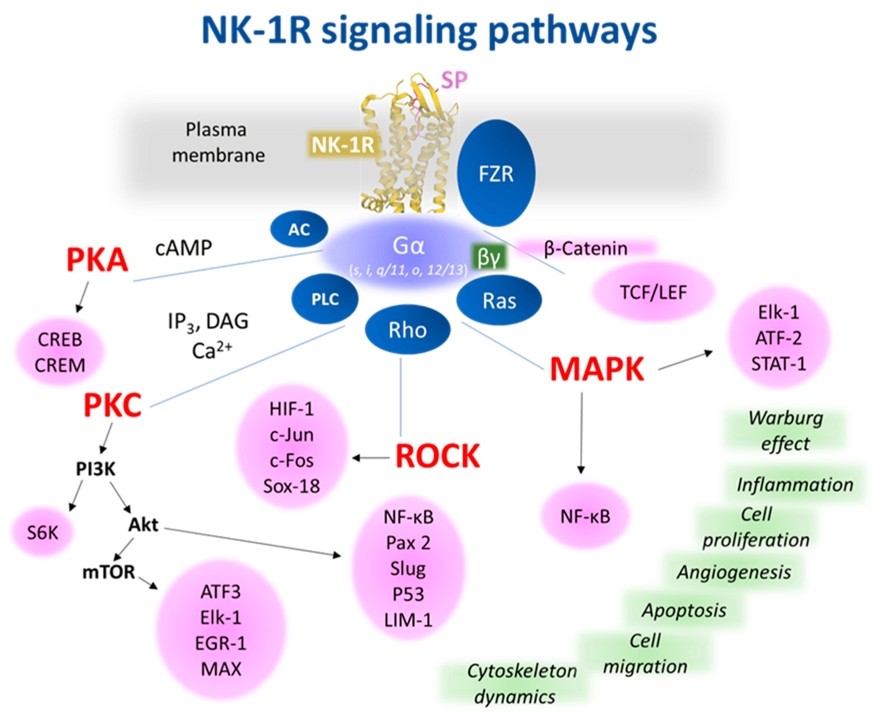Hi-Affi™ NK1 Stable Cell Line
Aiming at evaluating compound function profile at an early stage, Creative Biolabs now offers a full set of cell-based assays/products based on our unique Hi-Affi™ platform. By co-expressing non-labeled GPCRs and a special biosensor that can react to second messenger activities (i.e. calcium, cAMP, DAG), Hi-Affi™ GPCR stable cell lines provide a convenient and efficient tool for in-depth studying the agonistic/antagonistic potentials of various drug compounds targeting GPCRs. In particular, we would like to introduce Hi-Affi™ NK1 stable cell line to our customers all over the world.
Introduction to NK1 receptor
Substance P (SP) is an 11-amino-acid neuropeptide of the tachykinin family with other members including neurokinin A and neurokinin B. There are three receptor subtypes for the tachykinins: NK1, NK2, and NK3. It has been shown that SP preferentially binds to the neurokinin-1 receptor (NK1).
Neurokinin 1 receptor (NK1) is a G-protein coupled receptor which couples to a subgroup of G-proteins, Gq/11. Interaction with SP leads to activation of phospholipase Cβ (PLCβ) and results in a transient increase in intracellular inositol 1,4,5 triphosphate (IP3) diacyl-glycerol and cytosolic Ca2+ concentration. This interaction takes place in several different cell systems and participates in exocrine gland secretion (e.g., sialogogue), connective-tissue cell proliferation, pain transmission, vasodilatation, endocrine secretion, and neuroimmune modulation, etc.
 Fig.1 Representative NK-1R intracellular signaling pathways, which are possibly involved in cancer-associated processes.1, 2
Fig.1 Representative NK-1R intracellular signaling pathways, which are possibly involved in cancer-associated processes.1, 2
Hi-Affi™ NK1 Stable Cell Line
Hi-Affi™ NK1 stable cell line is constructed via stably transfecting of human Tachykinin/Neurokinin receptor 1 (NK1) and special calcium-responsive, membrane-associated biosensor in U2OS cells. In absence of calcium, fluorescence signal can only be observed on plasma membrane. Upon changes in calcium concentration (caused by NK1 activation), the biosensor will quickly translocate into cytosolic vesicles, thus translating NK1 activities into fluorescence signals. This cell line offers an efficient and straightforward tool to assess and quantify compound function potentials against NK1.
Featured Advantages of Hi-Affi™ NK1 Stable Cell Lines
- Time-, cost-saving
- Easy operations, with no special requirements for reagents or equipment
- Amendable for high-throughput format
- No modifications/labeling of NK1 or downstream pathways, maintaining the native signaling events
Creative Biolabs is committed to providing high-quality, custom-oriented service in every stage of drug discovery campaign. In addition to hNK1 biosensor cell line, we also offer many other Hi-Affi™ engineered cell line options to study cAMP-, DAG-related as well as multiplex pathway events of various GPCRs. If you cannot find your desired target in our catalog, we are always glad to establish a custom cell line upon request. Please contact us for more information and a detailed quote.
References
- Coveñas, Rafael, Francisco D. Rodríguez, and Miguel Muñoz. "The Neurokinin-1 receptor: A promising antitumor target." Receptors 1.1 (2022): 72-97.
- under Open Access License CC BY 4.0, without modification.
For Research Use Only.
